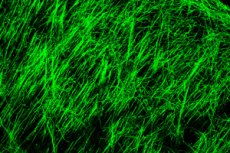New publications
A small molecule is promising for myelin sheath repair
Last reviewed: 02.07.2025

All iLive content is medically reviewed or fact checked to ensure as much factual accuracy as possible.
We have strict sourcing guidelines and only link to reputable media sites, academic research institutions and, whenever possible, medically peer reviewed studies. Note that the numbers in parentheses ([1], [2], etc.) are clickable links to these studies.
If you feel that any of our content is inaccurate, out-of-date, or otherwise questionable, please select it and press Ctrl + Enter.

When treated with a new inhibitor of protein function called ESI1, mice mimicking the symptoms of multiple sclerosis (MS) and lab-grown human brain cells showed the ability to restore vital myelin sheaths that protect healthy axon function.
The breakthrough, published in the journal Cell, appears to overcome difficulties that have long hampered previous attempts to reverse the form of nerve damage that robs people with MS of motor control and gradually reduces cognitive function in many people as they age.
"There are currently no effective therapies to repair myelin damage in devastating demyelinating diseases such as MS," says corresponding author Q. Richard Lu, Ph.D., a brain research expert at Cincinnati Children's. "These findings are significant because they suggest new avenues for treatment that potentially change the therapeutic focus from symptom management to actively promoting myelin repair and regeneration."
Stimulating Healing by Removing Obstacles
The critical insight that led to the new discoveries was the observation that damaged areas of the brain in MS still contain the type of cells needed to repair myelin damage, but the disease activates other cell types and signals that work together to suppress the repair function.
These helpful cells in the brain, called oligodendrocytes, are responsible for producing the myelin sheaths that wrap around the axons of nerve cells, like plastic insulation around a wire. When the protective myelin is damaged, whether by disease or wear and tear from age, nerve signaling is disrupted. Depending on where the damaged nerves lead, these disruptions can affect movement, vision, thinking, and more.
Essentially, the research team found a way to unlock the suppressed repair process, freeing up oligodendrocytes (OLs) to do their job.
Identifying the genetic changes and signals involved in the process of repair suppression and finding a small molecule compound that could reverse the suppression was a complex task. The project, which spanned more than five years, involved four co-authors and 29 co-authors from Cincinnati Children's, the University of Cincinnati, and 14 other institutions, including universities in Australia, China, Germany, India, Singapore, and the United Kingdom.
The team's main findings:
Identifying a mechanism that prevents myelin production in MS
Analysis of preserved autopsy tissue showed that OLs in MS lesions lack an activating histone mark called H3K27ac, while expressing high levels of two other repressive histone marks, H3K27me3 and H3K9me3, associated with the silencing of genetic activity.
Finding a compound that can reverse the suppression
The research team examined a library of hundreds of small molecule compounds known to target enzymes that can modify gene expression and affect suppressed OLs. The team found that the compound ESI1 (epigenetic silencing inhibitor-1) was nearly five times more potent than any other compound examined.
The compound tripled levels of the desired histone mark H3K27ac in OLs, while dramatically reducing levels of two repressive histone marks. In addition, the study revealed a new way in which ESI1 promotes the creation of special membrane-free regulatory nodes known as “biomolecular condensates” inside the cell nucleus that control levels of fats and cholesterol.
These nodes act as focal points for enhancing the production of essential fats and cholesterol needed to create myelin, an important component of nerve fibers.
Demonstrating benefits in mice and lab-grown human tissue
In both aging mice and mice that mimic MS, ESI1 treatment boosted myelin sheath production and improved lost neurological function. Testing included tracking gene activation, measuring microscopic new myelin sheaths surrounding axons, and seeing that treated mice were faster at completing a water maze.
The team then tested the treatment on lab-grown human brain cells. The team used a type of brain organoid called myelin organoids, which are much simpler than full-fledged brains but still produce complex myelinating cells. When the organoids were exposed to ESI1, the treatment lengthened the myelin sheath of the myelinating cells, the study reports.
Consequences and Next Steps
MS is the best known of several major neurodegenerative diseases. The new findings could inspire a new approach to halting the degenerative effects of these conditions, Lu says.
Myelin regeneration treatments may also be helpful for people recovering from brain and spinal cord injuries.
But the most far-reaching implication of the research is the possibility that ESI1 or similar compounds could be used to help slow or even reverse the cognitive losses that often occur with age. Many studies have shown that myelin loss plays a role in age-related cognitive decline, Lu says.
However, more research is needed to determine whether ESI1 can be put into clinical trials as a potential treatment. For example, the effects of ESI1 may need to be modified by adjusting the dose and duration of treatment or using “pulsed therapy” at specific time windows. More research is also needed to determine whether even more effective compounds than ESI1 can be developed.
"This study is just the beginning," says Lu. "Before the discovery of ESI1, most scientists thought that remyelination failure in MS was due to arrested progenitor development. Now we show proof of concept that reversing the downregulation of OLs present in the injured brain can allow myelin regeneration."
